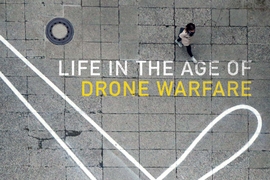Drones have become a common part of warfare — but their use remains a subject of public contention. Lisa Parks, a professor in MIT’s program in Comparative Media Studies/Writing and director of its Global Media Technologies and Cultures Lab, has spent extensive time analyzing this public debate. Now, she has co-edited a new volume examining the subject, while contributing a piece to it herself. The book, “Life in the Age of Drone Warfare,” has just been published by Duke University Press. MIT News talked with Parks this week about the impact and public perception of drones.
Q: We know much more about drones now, in 2017, than we did several years ago. How has the public understanding of drones evolved?
A: When the story first broke in 2009 about a secret CIA drone war on the Afghan/Pakistan border, there were many follow-up investigative reports. You also saw a lot of discussion in the news media suggesting that drones represented a “humane” kind of warfare, that they allowed the U.S. to minimize casualties through precision targeting in the war theater. … Drones, the logic went, made war more clean and antiseptic. Then people began to drill down more deeply and listen to public sentiment from around the world, as there were mass demonstrations, peaking in 2014, against drone wars, not only in Pakistan but also in London and Washington, D.C. Drones were being used in the war in Iraq, and Syria, and Libya as well … and [people were] trying to document in photographs and testimonials what these scenes looked like after a U.S. strike. So the picture became a little more complicated at that point, and there was more vociferous opposition and antiwar activity in relation to military drone technology.
Q: You have an essay in this book about the “vertical mediation” effect drones have, that is, that they are changing conditions on the ground just by being in the air. Could you explain this idea a little more?
A: I came at this topic as a media scholar who had studied war, media, and satellites in the past … and I was not satisfied with the existing media theories that were available. When you think about drones in the military context, you can’t limit the analysis to [drones] being like a video game, because the effects of the drone’s movements can change the material conditions in the air and on the ground. So we need a theory of what I call “vertical mediation” to grapple with the transformations that are happening between orbit and the ground. Drones, just by moving over an area, are [altering] life on Earth, reorganizing where and how people move, what their disposition is or what their feeling is about the sky above them — and who they want to be around and who they try to avoid. When drones are operating in an area over time, above a certain region, they change the status of sites and motions on the ground.
Q: But how different are drones from previous military tools? We had video game-like imagery from Gulf War in 1991, and there have been aerial bombing campaigns throughout the 20th century, which also altered how people act on the ground.
A: In the book we try to make clear that current forms of drone warfare are part of a longer history of aerial militarization, that this is not unique to the era of the drone. One chapter of the book, for instance, focuses on drone experiments during World War II. Today’s military drones arguably make warfare more flexible and mobile, but they still require extensive ground infrastructure, not to mention agreements with host countries. One of the most distinguishing aspects of drone use is that they have been mobilized to fight wars without public deliberation. Drones are being used right now, not just for warfare but for patrolling, [which] is a sign of how available they are to be mobilized. As a humanist and a social scientist, I’m very interested in the effects of drone use, on societies, economies, and cultures in different parts of the world.
Some critics align the drone with a kind of totalitarian tendency. There is a [video] parody called “The Ethical Governor,” which is about a world in which the drones run everything for us, and we delegate the power of public administration and governance to these automated entities. And that’s one vision, where the human becomes subservient to this new level of automation.
On the other hand, there’s a lot of optimism and DIY-hobbist, civilian-based impetus in drone technology too. We see a lot of that here at MIT. I never think a technology is just one thing. A lot of people are trying to design drones to do good things. Those efforts are sincere and important. At the same time, we [can] be surprised even by technologies designed to do good things: What happens if civilian drones get weaponized? We really need to be thinking about the complex potentials of a technology like the drone, and the different kinds of agencies or capabilities it enables. That’s what our book tries to investigate while bringing some new voices into the conversation who have the social good at heart.










